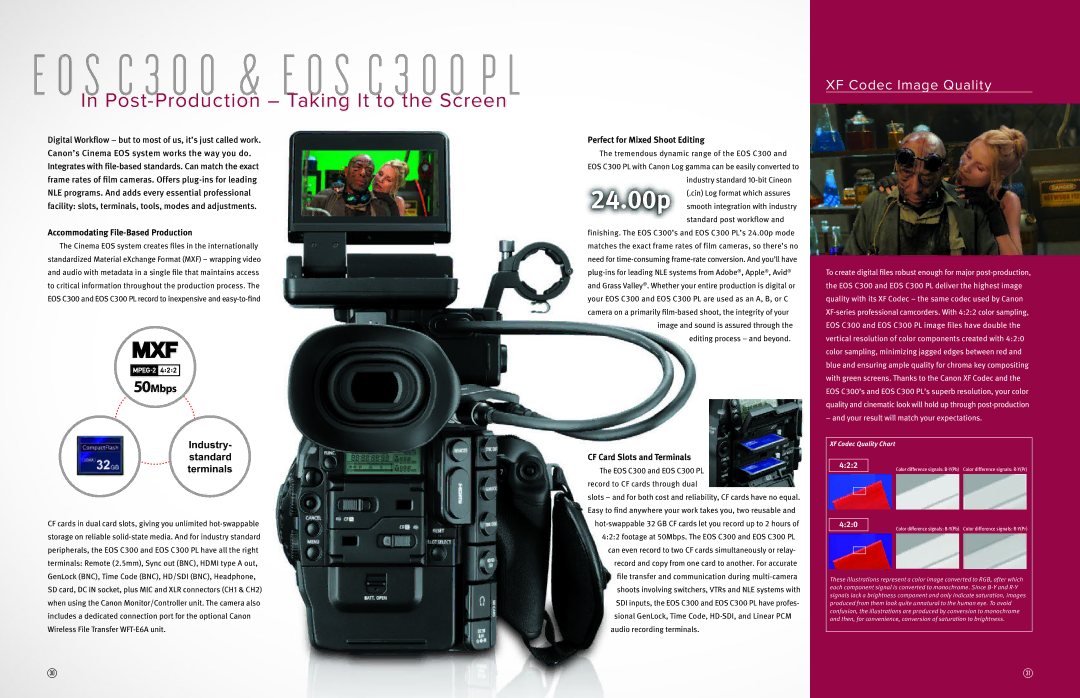In Post-Production – Taking It to the Screen
Digital Workflow – but to most of us, it’s just called work. Canon’s Cinema EOS system works the way you do. Integrates with file-based standards. Can match the exact frame rates of film cameras. Offers plug-ins for leading NLE programs. And adds every essential professional facility: slots, terminals, tools, modes and adjustments.
Accommodating File-Based Production
The Cinema EOS system creates files in the internationally standardized Material eXchange Format (MXF) – wrapping video and audio with metadata in a single file that maintains access to critical information throughout the production process. The EOS C300 and EOS C300 PL record to inexpensive and easy-to-find
Industry- standard terminals
CF cards in dual card slots, giving you unlimited hot-swappable storage on reliable solid-state media. And for industry standard peripherals, the EOS C300 and EOS C300 PL have all the right terminals: Remote (2.5mm), Sync out (BNC), HDMI type A out, GenLock (BNC), Time Code (BNC), HD/SDI (BNC), Headphone, SD card, DC IN socket, plus MIC and XLR connectors (CH1 & CH2) when using the Canon Monitor/Controller unit. The camera also includes a dedicated connection port for the optional Canon Wireless File Transfer WFT-E6A unit.
Perfect for Mixed Shoot Editing
The tremendous dynamic range of the EOS C300 and
EOS C300 PL with Canon Log gamma can be easily converted to
industry standard 10-bit Cineon
24.00p (.cin) Log format which assures smooth integration with industry
standard post workflow and
finishing. The EOS C300’s and EOS C300 PL’s 24.00p mode matches the exact frame rates of film cameras, so there’s no need for time-consuming frame-rate conversion. And you’ll have plug-ins for leading NLE systems from Adobe®, Apple®, Avid® and Grass Valley®. Whether your entire production is digital or your EOS C300 and EOS C300 PL are used as an A, B, or C camera on a primarily film-based shoot, the integrity of your
image and sound is assured through the editing process – and beyond.
CF Card Slots and Terminals
The EOS C300 and EOS C300 PL record to CF cards through dual
slots – and for both cost and reliability, CF cards have no equal. Easy to find anywhere your work takes you, two reusable and hot-swappable 32 GB CF cards let you record up to 2 hours of
4:2:2 footage at 50Mbps. The EOS C300 and EOS C300 PL can even record to two CF cards simultaneously or relay- record and copy from one card to another. For accurate file transfer and communication during multi-camera shoots involving switchers, VTRs and NLE systems with SDI inputs, the EOS C300 and EOS C300 PL have profes-
sional GenLock, Time Code, HD-SDI, and Linear PCM audio recording terminals.
XF Codec Image Quality
To create digital files robust enough for major post-production, the EOS C300 and EOS C300 PL deliver the highest image quality with its XF Codec – the same codec used by Canon XF-series professional camcorders. With 4:2:2 color sampling, EOS C300 and EOS C300 PL image files have double the vertical resolution of color components created with 4:2:0 color sampling, minimizing jagged edges between red and blue and ensuring ample quality for chroma key compositing with green screens. Thanks to the Canon XF Codec and the EOS C300’s and EOS C300 PL’s superb resolution, your color quality and cinematic look will hold up through post-production
– and your result will match your expectations.
XF Codec Quality Chart
4:2:2 | Color difference signals: B-Y(Pb) Color difference signals: R-Y(Pr) |
|
4:2:0 | Color difference signals: B-Y(Pb) Color difference signals: R-Y(Pr) |
|
These illustrations represent a color image converted to RGB, after which each component signal is converted to monochrome. Since B-Y and R-Y signals lack a brightness component and only indicate saturation, images produced from them look quite unnatural to the human eye. To avoid confusion, the illustrations are produced by conversion to monochrome and then, for convenience, conversion of saturation to brightness.

